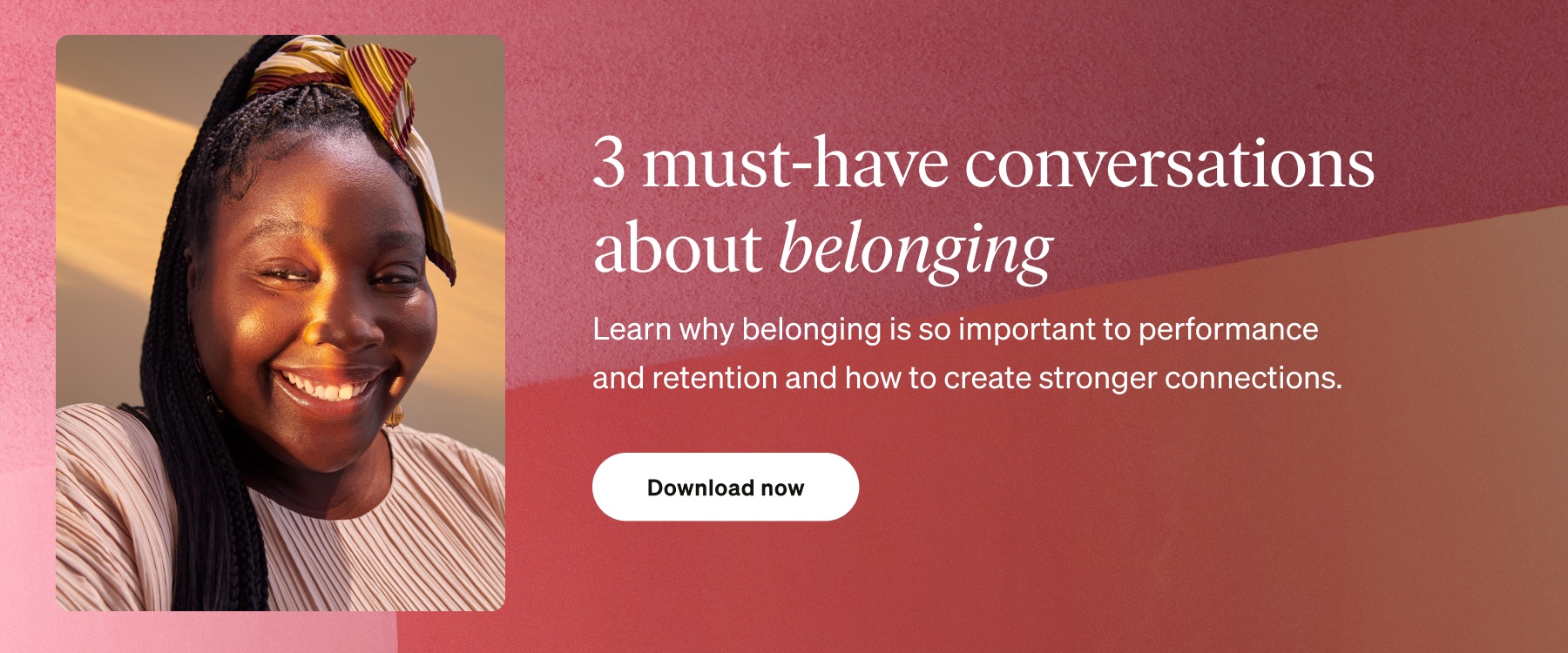-
For Business
For Business
Products
LeadBuild leaders that accelerate team performance and engagement.
Care™Drive productivity through sustained well-being and mental health for all employees with BetterUp Care™.
Solutions
Sales PerformanceTransform your business, starting with your sales leaders.
Diversity & InclusionFoster a culture of inclusion and belonging.
Customers
Case StudiesSee how innovative companies use BetterUp to build a thriving workforce.
- For Individuals
-
Resources
Resources
LibraryBest practices, research, and tools to fuel individual and business growth.
EventsView on-demand BetterUp events and learn about upcoming live discussions.
BlogThe latest insights and ideas for building a high-performing workplace.
ResearchInnovative research featured in peer-reviewed journals, press, and more.
- About

As we look to the future, meeting the needs for diversity and inclusion has gotten even more complex.
The work “place” has taken on a whole new meaning and form. Within teams, and across teams, various permutations of remote, hybrid, and fully in-person work are creating an entirely new dynamic.
Those in remote or hybrid work are likely to have concerns around voice, visibility, or perceptions of contribution. For those back in person, there is a re-learning and re-norming process unfolding. With the pandemic still gripping our lives, we still have questions: What are the best practices and policies, and how do they intersect with existing social norms and needs?
For everyone, how do we prevent a sense of “in-group” and “out-group” dynamics?
It’s a new era of work, one where the importance of inclusivity has risen. Yet, what it looks like to be inclusive has shifted.
We wanted to understand the degree of importance of inclusive leader behaviors on teams in this new era of work. So we looked at leaders and their direct reports on teams that have faced shifts in and out of remote or hybrid work this year. Here is what we found.
What the data say
Direct reports on these teams fell all along a continuum of belonging. All of the teams we looked at went through a major transformation of work arrangements this year — at least once. Therefore, teams with high belonging were highly interesting to us: what was the differentiating factor? What was their “secret”?
What we saw was this: direct reports with the highest levels of belonging had leaders who were particularly strong in specific kinds of leadership skills.
Most of these skills were core inclusive leadership skills. Teams with the highest belonging have leaders who are 25% higher on encouraging participation skills, 24% higher on alignment, 22% higher on empathy, 18% higher on recognition, 16% higher on social connection, and 6% higher on relationship building.
Why it matters
These data underscore that leaders must step up to reinforce, reassure, and show that team members in remote and hybrid arrangements are equal team members. By amplifying their inclusive behavior, leaders can ensure that all team members understand, and feel, that remote and hybrid members contribute the same value, have the same opportunities, and are included the same as others who are in-person.
When leaders do this it’s crystal clear: hybrid and remote team members are much more likely to feel high belonging.
Across years of data, we have seen these leader skills drive belonging and performance. When leaders are inclusive, their teams are:
- 50% more productive
- 90% more innovative
- 150% more engaged
- 54% lower in turnover intention.
But it’s not just during changes in work arrangements when inclusive leader skills are important. Although it feels like this moment is unique, a never-been-seen-before shift, the underlying human experience of change is uncertainty. Uncertainty is core to how we experience change.
So, just like most other major changes and disruptions, the current shifts around return to work and hybrid work carry with them a burden of fear. Many, consciously or not, feel a threat to our basic human needs.
For example, regardless of one’s ultimate arrangement, there is uncertainty around the implications it carries for group membership, status, acceptance, social connection, social capital, voice, recognition, and respect. The “flavor of the day” is change associated with return to work and hybrid work trends. But when the current phase of change is over, you can bet there will be another major disruption around the corner. That change is likely to carry with it similar feelings of uncertainty and threat. And leaders will need to be ready for that too.
Change is continual, and teams and organizations have to constantly adapt. And as long as change is inherently coupled with uncertainty, leadership that fosters inclusion and belonging will always be a powerful hedge against the deeply human forms of stress and fear that occur during change.
Erin Eatough, PhD
Sr. Insights Manager





